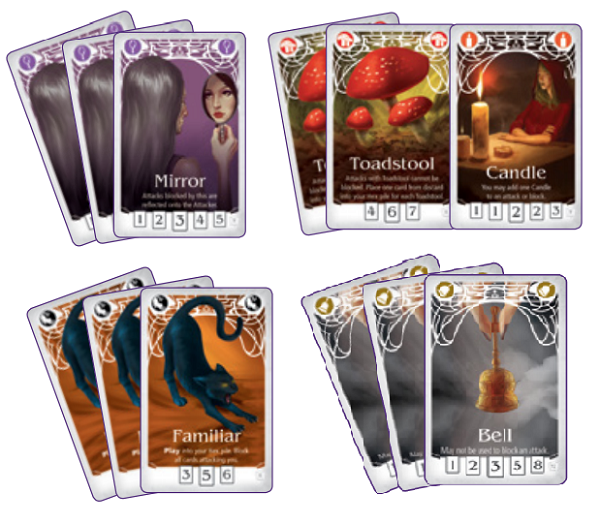Bewitch and Befuddle in the Witching Hour

Hex your opponents, deflect attacks, and call familiars to your aid! Witching Hour is a light, easy to learn card game with a very witchy theme.
A fast playing card game from Indie Boards & Cards, Witching Hour feels reminiscent of several family-friendly card games, and as such makes it one that’s easy to teach a wider audience.
Gameplay
At the start of the round, the deck of cards is shuffled and thirteen cards (ten in a five player game) are dealt to each player. The remaining cards in the deck are placed face-down, forming the discard pile.
Each card type in the deck has an ability. Each type also says how many points you score based on the number of that card type in your hex pile at the end of the round. For example, the chalice is worth negative three points in your hex pile if you only have one, but if you have two you get one point, while if you have three, you earn five.
On your turn, you may either play a card or attack. When attacking, you choose a number of matching cards from your hand, and play them against any player. To defend, that player must play an equal number of cards that match each other. If a player successfully defends, the attacking and defense cards are all added to the discard pile. If a player is not able to defend, the attacking cards are placed in his hex pile.
Some cards have an ability that you can play on your turn instead of attacking. Most require you to play the card into your own hex pile in order to trigger the ability. For example, you may play the hourglass into your hex pile and this allows you to look at your hex pile and add a card from it into your hand, and you then take another turn; while the skull lets you take any card from the discard pile and add it to your hand. Some cards have abilities that trigger at other times, such as the familiar which you may play alone to block an attack but then must add the familiar to your hex pile.
The round ends once only one player has any cards left in hand. That player then adds the rest of his hand to his hex pile. Players calculate the points they earn for each card type in their hex piles, and then begin a new round. The player with the lowest score after three rounds wins the game.

Review
Witching Hour is one of those card games that are really accessible and easy to teach people who don’t play many games. Families can easily play it. Its rules are simple and easy to learn, helpful player aid cards are included and the information is nicely presented on each card itself. This is a game that’s easy to pull out and play, takes up minimal space, and is good for small gatherings or parties.
There’s some interesting card play here, as well, however. Which cards do you use for their abilities and which do you use for attacks? You might have a large number of one card type; do you use it all in a single attack or hold some back to defend yourself? And which players are most helpful to attack? There is a memory element to the game as well — unless it is through a card ability, you are not allowed to look through your hex pile, so you have to try to remember what is already there as well as what is in each opponent’s pile so you know the most effective way to give them points. Because of this element, we don’t recommend the game at two players, as part of the fun is choosing how to spread your cards out.
The cards are a nice thick quality, and the artwork fits the game well. This would certainly be a fun game to add to a Halloween game night. The printing on the cards is, however, just a little off with the artwork sometimes looking a little faded against the texture of the cards themselves.
Witching Hour isn’t a very big game or an ambitious one, but its light and fun. Its theme is enjoyable and there is some fun player interaction and choices packed into a quite accessible, portable little game.
Pros: Accessible to a wider audience, thematic, cards serving multiple purposes result in some interesting decisions
Cons: Not good for two players, printing on the cards could be improved
Disclosure: we received a complimentary review copy of this game.






